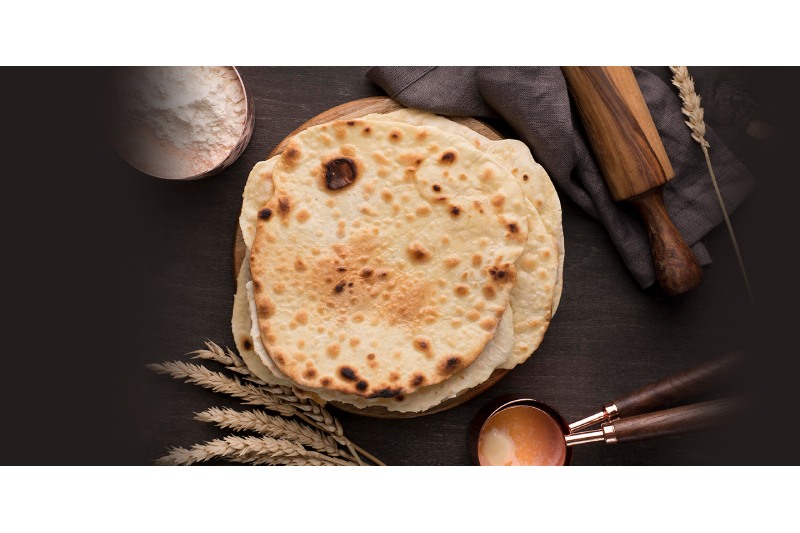Which Roti are the Healthiest?

Beyond just being a tasty side dish for your curry, roti is a common fixture. Rich in nutrients, it makes a substantial contribution to a diet that is well-balanced. Every variety of roti has different health advantages, depending on the kind of flour used. This is all the information you require regarding the nutritional characteristics of the several kinds of rotis, specifically the whole wheat, Bajra, oat, Kuttu, and Ragi rotis.
Roti is a staple food, but it’s important to educate people about its calorie count, the vitamins and minerals it contains, and the reasons you would want to incorporate it in your diet.
Traditional Whole-Wheat Roti
A traditional option, whole wheat roti is cherished for its mild flavor and soft texture. Its high dietary fiber content, which supports good blood sugar regulation and digestion, comes from using whole wheat flour in its production.
The nutritional content of 1 30-gram whole wheat roti
- Calories: 71
- Protein: 3g
- Fat: 0.4g
- Carbohydrates: 15g
- Fibre: 2.5g
B vitamins, especially niacin (B3), which is essential for DNA repair and energy metabolism, are abundant in whole wheat rotis. They also contain minerals that are necessary for the health of bones and the synthesis of energy, such as phosphorus and magnesium.
Roti Bajra
Pearl millet, also known as bajra, is an ancient grain prized for its high nutritional content and tenacity. Bajra rotis have a nutty taste and a texture that is slightly gritty.
The approximate 30g nutritional content of 1 bajra roti
- Calories: 97
- Protein: 3.5g
- Fat: 1.2g
- Carbohydrates: 18g
- Fibre: 2.8g
Because bajra rotis are so high in iron, they’re a great option for combating anemia. They also include a healthy dose of magnesium, which supports heart rhythm health and muscle function. Bajra is suitable for people with celiac disease or gluten intolerance because it is gluten-free.
Roti with Oats
Oats are known to be heart-healthy, and oats roti is a great way to enjoy these advantages. Their texture is slightly chewy, and their flavor is modest but delicious.
The approximate 30g nutritional content of 1 oat roti
- Calories: 75
- Protein: 3g
- Fat: 1g
- Carbohydrates: 14g
- Fibre: 2g
A great source of soluble fiber, especially beta-glucan, which has been demonstrated to decrease cholesterol and enhance heart health, is rolled oats. They also include healthy levels of phosphorus and manganese, which are essential for the development of bones and the metabolism of nutrients.
Kuttu Roti
Buckwheat, or kettu, is a common food during fasting periods. Buckwheat is naturally gluten-free and unrelated to wheat, despite its name.
One Kuttu roti’s nutritional value (approx. 30g)
- Calories: 84
- Protein: 3g
- Fat: 0.6g
- Carbohydrates: 18g
- Fiber: 2.7g
Rich in rutin, a bioflavonoid that fortifies capillaries and promotes blood circulation, kuttu rotis are a great food. Additionally, they contain significant levels of potassium and magnesium, which promote heart health and help control blood pressure.
Ragi Roti
Finger millet, or ragi, is prized for having a high calcium content, which is necessary for strong bones. The flavor of ragi rotis is distinct and slightly sweet, and their texture is substantial.
1 ragi roti’s nutritional value (approx. 30g)
- Calories: 89
- Protein: 2.8g
- Fat: 0.9g
- Carbohydrates: 18g
- Fiber: 2.7g
Because ragi rotis have a very high calcium content, they are great for keeping teeth and bones strong. They are also a good source of iron and amino acids, such as methionine, which are necessary for the body’s detoxification and maintenance of healthy skin and hair.
It’s critical to switch up your roti selections to ensure you’re getting a wide range of nutrients because each variety adds a different set of nutritional advantages to your meal. B vitamins and fiber are abundant in whole wheat roti, iron and magnesium are found in Bajra roti, heart-healthy fibre is found in oat roti, minerals and bioflavonoids are found in kuttu roti, and calcium and iron are found in ragi roti. You can make sure you get a variety of nutrients by include these various rotis in your diet, which will promote your general health and wellbeing.